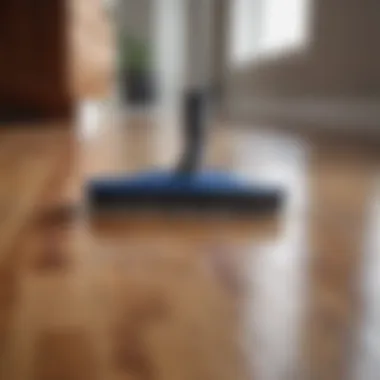Steam Mops and Laminate Floors: What You Need to Know


Intro
Laminate wood floors are a popular choice for many homeowners due to their durability and aesthetic appeal. They offer the appearance of hardwood while being more resistant to scratches and fading. However, maintaining these surfaces requires proper care and consideration.
In recent years, steam mops have gained traction as a cleaning tool, promising to eliminate dirt and grime effectively. While they provide a convenient option for many, their compatibility with laminate floors is often questioned. This article evaluates both the benefits and limitations of using steam mops on laminate surfaces.
By diving into maintenance best practices and potential risks, this piece aims to equip homeowners and cleaning professionals with useful insights. Understanding the relationship between steam cleaning and laminate flooring is crucial for ensuring the longevity and beauty of these surfaces.
Benefits of Steam Mops on Laminate Floors
Steam mops can deliver a high level of cleanliness and sanitation due to their ability to heat water and create steam. The hot steam can dissolve tough stains and eliminate bacteria. For busy households, this efficient cleaning method can save time, allowing one to maintain a tidy home without investing considerable effort.
Features of Steam Mops
- Fast Drying: The steam evaporates quickly, leaving behind a minimal amount of moisture which reduces drying time.
- Chemical-Free Cleaning: Using only water means that no harsh chemicals are required. This is beneficial for families with children or pets.
- Convenient to Use: Most steam mops are lightweight and easy to maneuver, making them accessible for quick cleaning tasks.
"Steam cleaning can be appealing for its quick sanitary benefits. However, care must be taken when using it on sensitive surfaces like laminate."
Drawbacks of Steam Mops on Laminate Floors
The potential risks of using steam mops on laminate wood floors cannot be overlooked. Laminate is not solid wood; it consists of several layers, including a fiberboard core. Excessive moisture introduced by steam can penetrate seams and lead to warping or delamination over time.
Key Concerns
- Moisture Damage: Even a few minutes of heat and humidity can weaken adhesive bonds beneath the surface.
- Heat Sensitivity: High temperatures may cause the laminate surface to warp, especially if the mop is held in one spot for too long.
- Limited Effectiveness on Certain Stains: Some types of stains may require additional cleaning agents for effective removal, which steam alone may not handle well.
Best Practices for Using Steam Mops on Laminate
To safely utilize steam mops on laminate flooring, it is essential to follow specific guidelines that help mitigate risks:
- Check Manufacturer Recommendations: Always refer to the laminate floor manufacturer's guidelines regarding steam cleaning.
- Test a Small Area: Before full application, try the mop on a less visible section of the floor to ensure it does not cause damage.
- Use a Microfiber Pad: This helps absorb moisture and reduces the amount of steam released at once.
- Avoid Overuse: Limit steam cleaning sessions to prevent excessive moisture build-up.
- Use Low Heat Settings: If available, opt for low-temperature options to further reduce the risk of heat damage.
Suitable Cleaning Methods for Laminate Floors
In addition to steam cleaning, various methods keep laminate floors looking pristine without compromising integrity.
- Dry Dusting: Regularly using a dry mop or broom helps remove dust and dirt without moisture.
- Damp Mopping: Using a slightly damp cloth with a laminate-safe cleaner can effectively lift stains while safeguarding the floor from water damage.
- Spot Treatment: For tough stains, consider using a cleaner designed for laminate wood floors. Always follow the product instructions for maximum effect.
By understanding both the capabilities and limitations of steam mops, users can make informed choices about their cleaning methods to best protect laminate flooring. This balanced approach aids in extending the life of these stylish surfaces.
Foreword to Steam Mops
The use of steam mops represents a significant advancement in home cleaning technology. Their integration into modern housekeeping practices offers several advantages, particularly for hard surface floors. Understanding the role of steam mops is essential for homeowners looking to maintain various floor types, including laminate wood flooring.
Steam mops harness the power of steam to clean and sanitize surfaces. This functionality presents a convenient and efficient cleaning solution that resonates especially with individuals who value chemical-free cleaning alternatives. As concerns for indoor air quality increase, many residents turn to options like steam mops that minimize harsh chemicals in their homes.
However, while benefits exist, it is critical to consider the compatibility of steam mops with specific flooring types. Laminate wood floors require particular care to avoid damage. Misuse can lead to exposure to excessive moisture, which can compromise the integrity of the flooring. Thus, knowing how steam mops function and their recommended usage is vital for maintaining the elegance and lifespan of laminate surfaces.
Definition of Steam Mops
Steam mops are specialized cleaning devices designed to facilitate the process of cleaning floors using pressurized steam. These mops usually consist of a handle and a cleaning head, which emits steam when activated. Water in a storage reservoir heats up, converting to steam that is released onto the floor surface through a microfiber pad.
The primary appeal lies in their ability to disinfect floors without the need for chemical cleaners. This feature is particularly attractive for households with children or pets, where exposure to harmful chemicals is a concern. The high temperature of steam kills bacteria and viruses, providing an effective solution for sanitation.


Mechanism of Action
The action of steam mops relies on a simple yet effective principle: heat and moisture. When the steam is expelled, it loosens dirt, grime, and other debris from the floor surface. The microfiber pad attached to the mop head then captures and absorbs the loosened particles, leaving the floor clean and sanitized.
Using steam mops involves a process of the following key steps:
- Heating: Water in the mop's reservoir is heated to a temperature that generates steam.
- Steam Release: As the steam is released through the mop head, it comes into contact with the floor.
- Soil Dissolution: The heat from the steam penetrates dirt and grime, making it easier to wipe away.
- Cleaning: The microfiber pad collects the loosened debris, effectively cleaning the surface.
This method not only cleans but also significantly reduces the potential for harmful microorganisms to survive on the surface. Still, users must be cautious and follow manufacturer guidelines for best practices to avoid damaging laminate flooring.
Overview of Laminate Wood Floors
Understanding laminate wood floors is important in the context of using steam mops. This section delves into the composition and challenges associated with laminate flooring. Knowing these elements can help homeowners make informed decisions regarding cleaning methods. Many choose laminate for its attractive appearance and versatility. However, careful maintenance is necessary to preserve its aesthetic appeal and longevity.
Composition of Laminate Flooring
Laminate flooring consists of several layers, which contribute to its overall durability and appearance. The primary layers include:
- Wear Layer: The topmost layer protects against scratches and stains. This protective coating can be critical in maintaining the flooring's visual aspects.
- Design Layer: Below the wear layer, this contains the printed image of wood or stone, offering the desired aesthetic. It allows for diverse designs that can imitate other materials entirely.
- Core Layer: Made from high-density fiberboard, it provides stability and strength. This layer influences how well the floor withstands heavy foot traffic.
- Backing Layer: The bottom most layer acts as insulation, providing moisture resistance and adding overall support to the laminate.
The combination of these layers gives laminate durability and a sophisticated look. However, understanding the unique structure can help users choose appropriate cleaning methods.
Durability and Maintenance Challenges
Laminate flooring is known for its resilience, yet it can encounter specific maintenance challenges. Homeowners should be aware of potential issues such as:
- Water Sensitivity: While many laminates are designed to resist moisture, excessive water can lead to warping or buckling over time. It’s crucial to avoid letting water sit on the surface.
- Scratches and Dents: Despite the protective wear layer, laminate can still scratch or dent from heavy objects. Care should be taken when moving furniture or other items to avoid damage.
- Fading: Exposure to direct sunlight may cause the laminate's color to fade. This means that placement of rugs or blinds can be beneficial.
The maintenance of laminate floors requires an understanding of its strengths and limitations. This knowledge informs the cleaning processes to adopt, helping prevent inadvertent damage from methods such as steam cleaning.
Key Consideration: Always refer to the manufacturer's guidelines for cleaning and maintaining laminate flooring to ensure longevity and avoid costly repairs.
Compatibility of Steam Mops with Laminate Floors
Understanding the compatibility of steam mops with laminate wood floors is pivotal in maintaining the integrity and appearance of the flooring. Laminate floors, made from layered materials and resin, are sensitive to excessive moisture and heat. Thus, using the correct cleaning methods can prolong their lifespan and enhance their aesthetic appeal. The discussion here addresses relevant manufacturer recommendations and the risks involved, giving homeowners a clear picture of proper care practices.
Manufacturer Recommendations
Most manufacturers offer clear advice regarding the use of steam mops on laminate surfaces. Many suggest avoiding steam cleaners, as the high temperature and moisture can lead to damage over time. For instance, companies like Pergo and Quick-Step explicitly caution against steam cleaning, emphasizing that it may void warranties due to the potential risks involved. Instead, they recommend using a damp mop or a specialized cleaner designed for laminate.
Homeowners should always consult the guidelines provided by their specific laminate flooring brand. This ensures compatibility with steam mops to prevent possible warranty disputes or unanticipated damage. Following manufacturer advice contributes significantly to maintaining the floor’s durability and appearance, fostering an environment where the floor can withstand daily use without compromise.
Potential Risks of Steam Cleaning
The choice to use steam mops includes understanding potential risks associated with laminate flooring. There are primary concerns that often arise, notably water damage and the propensity for peeling or warping.
Water Damage
Water damage is a significant risk when using steam mops on laminate floors. The elevated moisture levels can seep into the seams, leading to swelling and deterioration. This structural compromise might not present immediately but can lead to serious long-term issues. Key characteristics of water damage involve discoloration and a warped appearance, making it one of the most detrimental outcomes from improper cleaning techniques.
Homeowners should be cognizant of how steam mops can inadvertently expose their flooring to these dangers. While steam is an effective cleaning solution generally, the complications water exposure brings can negate its utility.
Peeling or Warping
Peeling or warping of laminate floors could also result from steam mopping. These effects manifest when the laminate absorbs moisture, causing the surface layer to separate or lift. The thin structure of laminate makes it susceptible to these changes, which can severely affect the visual appeal and usability of the flooring.


Peeling exposes underlying layers, which can be unattractive and difficult to repair effectively. The decision to steam clean should always be weighed against these risks. Homeowners often seek popular cleaning solutions, but understanding the unique features of peeling or warping helps underscore the importance of alternative cleaning methods.
In summary, while steam mops might appear beneficial for ease of cleaning, their compatibility with laminate wood flooring brings forth substantial risks. Homeowners must practice due diligence by aligning with manufacturer guidance and considering safer cleaning alternatives to sustain their laminate floors.
Benefits of Using Steam Mops on Laminate Floors
Steam mops have become increasingly popular among homeowners looking to maintain their laminate wood floors. Understanding the benefits of using these steam cleaning devices can inform better cleaning practices and enhance the longevity of laminate surfaces. This section will delve into how steam mops can effectively clean, provide a chemical-free solution, and ultimately support a healthier living environment.
Effective Removal of Dirt and Germs
One of the most significant advantages of using steam mops is their capability for effective dirt and germ removal. The high temperature of the steam can penetrate various surface soils, loosening grime and debris that traditional mopping may miss. This can be particularly appealing for households with young children or pets, where cleanliness is of utmost importance.
Steam mops contribute not only to aesthetic cleanliness but also play a role in hygiene. The hot steam can kill germs and bacteria without harsh chemicals. This is crucial for anyone concerned with allergens or contaminants.
- Steam mops sanitize without the addition of chemical cleaners.
- They are equally adept at removing tough stains, grime, and sticky residues.
- Regular use can result in fewer germs, promoting a healthier living environment.
"Steam cleaning is an effective method for sanitizing surfaces, providing peace of mind to households."
Chemical-Free Cleaning Solution
Another notable benefit of steam mops is the ability to clean laminate floors without resorting to store-bought cleaning solutions laden with chemicals. This is a significant advantage for environmentally conscious individuals or those sensitive to chemical fragrances.
Using a steam mop, homeowners can maintain a clean floor using just water. The steam produced can dissolve dirt and grime effectively, providing an efficient and eco-friendly alternative to traditional cleaning methods. The absence of additional chemicals means that no residue is left behind, ensuring that the floor remains safe and clean for everyone, especially children and pets.
Best Practices for Steam Mopping Laminate Floors
Steam mopping laminate floors can be an effective cleaning method, but certain best practices should be followed to ensure that the floors are cleaned properly without causing damage. This section focuses on key elements that ensure the effective maintenance of laminate wood floors while utilizing steam mops. Following these best practices can extend the lifespan of the flooring and maintain its visual appeal.
Choosing the Right Steam Mop
Selecting a suitable steam mop is critical to achieving the best cleaning results. A steam mop needs to deliver convenience while ensuring safety for laminate wood floors.
Adjustable Steam Settings
Adjustable steam settings allow the user to control steam output based on cleaning needs. This feature is important because laminated floors can be sensitive to high moisture levels. A steam mop equipped with adjustable settings lets homeowners choose low steam for laminate floors, preventing potential damage.
Key characteristics of adjustable steam settings include flexibility and control. These settings make it a popular choice among homeowners who want to customize their cleaning method. However, users must be aware that improper use can still lead to water damage, hence vigilance is necessary.
Microfiber Cleaning Pads
Microfiber cleaning pads play a significant role in the effectiveness of steam mops. They are designed to trap dirt and debris more effectively than traditional cleaning cloths. This ensures a more thorough cleaning experience without scratching or damaging the laminate surface.
Another characteristic of microfiber pads is their ability to be reused and washed. This makes them a cost-effective and environmentally friendly option. The unique feature of microfiber is its softness, which minimizes wear on laminate floors. Despite their benefits, users should wash them regularly to maintain cleaning efficiency.
Preparing the Floor
Preparation is key when steam mopping laminate floors. Properly prepping the area ensures optimal cleaning and protects the flooring material.
Clearing Furniture
Clearing furniture from the cleaning area allows for unrestricted access to all parts of the floor. This step is essential because it helps in ensuring that the entire surface is cleaned without interruptions. It also helps avoid accidents caused by slipping on furniture that may not be easily visible.
By removing furniture, users can be more thorough in their cleaning approach. Although this might seem inconvenient, it ensures all spots are addressed. Additionally, this practice can prolong the cleaning process, which may not be suitable for those in a hurry.
Pre-Sweeping or Vacuuming


Pre-sweeping or vacuuming the floor before steam mopping is a crucial step. This practice helps to remove loose dirt and particles that a steam mop might otherwise push around. Various methods like sweeping or vacuuming can prevent dirt from being driven deeper into the floor, preserving the laminate’s integrity.
This process can be beneficial as it ensures that steam mopping is as effective and efficient as possible. Yet, some might find it to be an extra chore; however, it is worth the effort to achieve a thorough clean.
Proper Technique for Steam Mopping
Employing the correct technique is vital for effective steam cleaning on laminate floors. It can make a big difference in cleanliness and overall floor condition.
Consistent Movement
Maintaining a consistent movement with the steam mop can help ensure even cleaning across the surface. By keeping the mop in motion, users reduce the risk of excessive moisture accumulation in one spot, which can lead to damage.
The key characteristic here is balance; moving steadily and not pausing too long in one area caters to effective moisture control. However, some may find this challenging, especially in tricky corners, as it may mean needing to slow down and adjust their cleaning method accordingly.
Test Cleaning Small Areas
Before fully steam mopping a large area, it is prudent to test a small section first. This allows homeowners to observe how the laminate reacts to steam cleaning. Testing provides insights into potential issues without risking damage to larger sections.
Testing small areas is particularly beneficial for those unsure about their specific floor type. However, users should be aware that testing can take extra time, though it is a wise precaution to ensure successful cleaning overall.
Alternatives to Steam Mopping for Laminate Floors
Understanding alternatives to steam mopping is crucial for maintaining the integrity of laminate wood floors. While steam mops are popular for their ease of use and effectiveness in cleaning, they may cause damage to laminate surfaces. Hence, exploring other methods of cleaning becomes necessary for protecting these floors in the long run.
Mopping with Damp Cloths
Using a damp cloth for cleaning laminate flooring is a simple yet effective method. To begin, you should lightly moisten a microfiber cloth with water, avoiding excess moisture. This approach leverages the absorbent nature of microfiber to trap dirt and debris without introducing too much liquid, which could lead to warping or swelling of the floorboards.
Benefits of Mopping with Damp Cloths:
- Low Water Usage: Since laminate is sensitive to water, a damp cloth minimizes any risk of water damage.
- Quick Drying: This method allows the floor to dry almost instantly, reducing the chance of slips or falls.
- Ease of Access: Most households already have microfiber cloths available. Therefore, this method does not require purchasing specialized cleaning tools.
The key to effective damp mopping lies in the frequency of cleaning and the products used. One must ensure the cloth is never soaking wet, and regular cleaning helps in preventing stubborn stains.
Using Floor Cleaners Designed for Laminate
In case of tougher stains or cleaning requirements, using cleaners specifically formulated for laminate floors is another reliable alternative. These products are designed to provide effective cleaning without causing damage. Here’s what to consider:
- Read the Labels: Always check if the cleaner is compatible with laminate flooring. Non-compatible products can lead to a dull finish or damage.
- Follow Instructions: Proper usage according to the guidelines can maximize effectiveness while ensuring safety for your floors.
- Application Method: Most cleaners can be applied directly onto the floor or on a cloth. Using a cloth to clean is preferred as it gives better control over excess moisture.
Benefits of Using Floor Cleaners:
- Targeted Cleaning: Specialized cleaners can effectively break down tough grime and stains that water might not handle.
- Protective Elements: Some cleaners also have formulations that can protect the floor's finish, helping to maintain its shine.
- Convenience: Many of these cleaners are user-friendly and designed for quick application, making the maintenance process smoother.
The End
In examining the use of steam mops on laminate wood floors, it’s essential to consolidate key insights that emerge throughout this article. This topic holds significant relevance for both homeowners and cleaning professionals. A thorough understanding of the implications of steam cleaning can lead to better maintenance and preservation of laminate flooring, which is a common choice in many households.
Summary of Key Points
This article discusses several critical factors surrounding steam mop use on laminate floors:
- Compatibility: Steam cleaning may not be suitable for all laminate floors. It is crucial to review manufacturer guidelines to avoid potential damage, such as warping or peeling.
- Benefits: Steam mops effectively eliminate most dirt and germs while offering a chemical-free cleaning alternative. This can be an appealing option for those looking to maintain a healthier home environment.
- Dangers: Though steam mops provide notable advantages, misuse can lead to serious issues. Understanding the risks associated with excessive moisture is vital.
- Alternatives: Traditional mopping methods and the use of laminate-specific cleaners can offer safer and effective options, which are discussed as viable alternatives.
- Best Practices: Following specific practices, like choosing the right steam mop and preparing the floor correctly, can enhance cleaning efficacy while minimizing risks.
Recommendations for Homeowners
Homeowners should carefully consider the following recommendations:
- Know Your Flooring: Familiarize yourself with the specifications of your particular laminate flooring. Each brand and type may have different guidelines for cleaning.
- Select Appropriate Tools: Opt for steam mops designed with adjustable settings. This allows for better control over steam output, which is crucial for maintaining the integrity of the laminate.
- Prepare Before Cleaning: Always clear the area of furniture and debris before mopping. A clean surface makes for a more efficient cleaning experience and protects the floor from scratches.
- Adhere to Recommended Techniques: Employ gentle movements while using a steam mop. Testing in small areas first can safeguard against unwanted outcomes.
- Explore Alternatives: If in doubt, explore mopping with a damp cloth or specialized floor cleaners. These methods may prove to be more compatible with your laminate flooring.
By following these guidelines, homeowners can effectively extend the life of their laminate floors while maintaining a clean and healthy environment. This careful approach ensures that the many benefits of laminate flooring can be enjoyed without risk.



